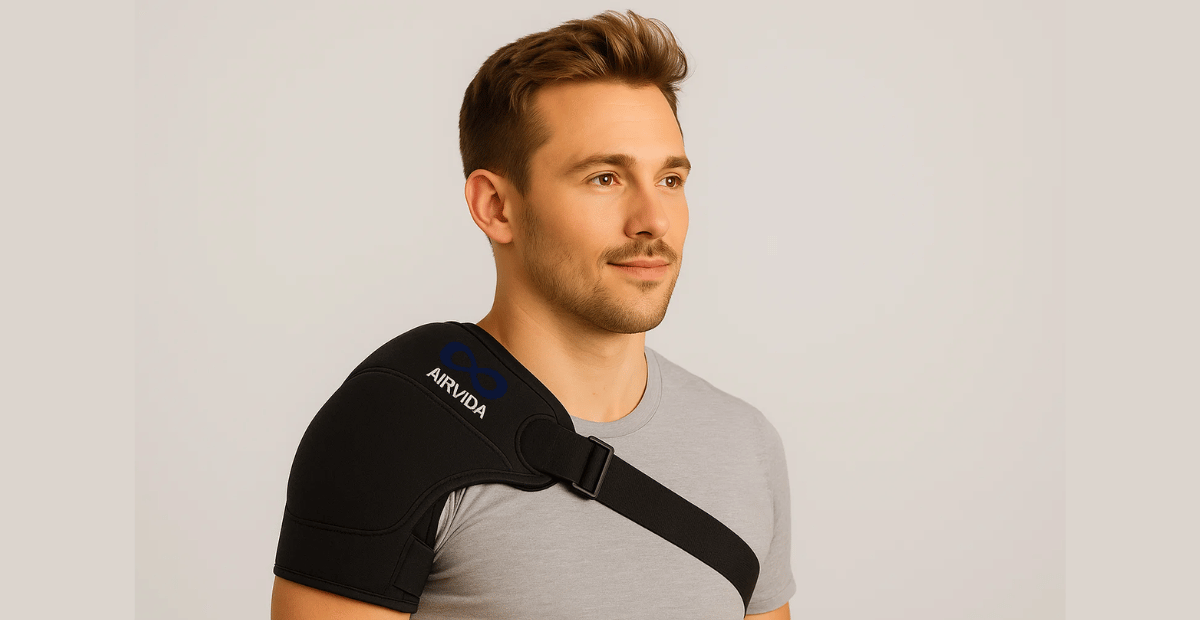Finding the best cold therapy machine for shoulder recovery can make a huge difference for anyone dealing with pain, swelling, or stiffness. Whether you’re healing from surgery, recovering after an intense workout, or managing chronic discomfort, targeted cold therapy can help reduce inflammation and improve mobility more effectively than traditional ice packs.
This article will discuss what makes these machines stand out, the key benefits they provide, and how to choose one that best fits your needs. We’ll also cover who may benefit the most and what to keep in mind before making a purchase. Keep reading to discover how the right device can support your recovery and overall shoulder health.
What Is a Cold Therapy Machine?
A cold therapy machine is a device designed to deliver continuous, controlled cooling to a specific area of the body, such as the shoulder. It typically works by circulating chilled water or using advanced iceless cooling technology. The goal is to reduce swelling, numb discomfort, and support healing by maintaining a steady cold temperature far longer than a traditional ice pack can.
For shoulder recovery, this precision is especially helpful since the shoulder is a complex joint with many muscles and tendons that benefit from consistent care. Whether you’re healing after surgery, easing a sports injury, or simply managing soreness from daily activity, the best cold therapy machine for shoulder support offers both convenience and efficiency.
Comparing Ice Packs vs. Cold Therapy Machines
While both methods aim to provide relief through cold application, there are important differences to consider.
-
Ice packs are inexpensive and easy to use, but often melt quickly, provide uneven coverage, and require constant replacements.
-
Cold therapy machines deliver steady, longer-lasting cooling that surrounds the joint more effectively. Some advanced models even include dual functions like heat therapy, timers, and adjustable intensity levels.
-
Ice packs may still work well for short-term or occasional use, while machines are better suited for ongoing or post-surgical recovery.
If you’re evaluating the best option for shoulder relief, it often comes down to convenience, effectiveness, and how frequently you expect to need therapy.
Types of Cold Therapy Machines for Shoulder Relief

When exploring recovery tools, it’s easy to get overwhelmed by the wide range of options on the market. Each device is built with different features, purposes, and levels of support in mind. Not all devices are the same, and understanding the types available can help narrow your choices:
1. Iceless Cold Therapy Machines – Use modern cooling technology to avoid the need for constant ice replacement. These are convenient and user-friendly.
2. Ice-Based Circulating Machines – Rely on ice and water that is circulated around the shoulder through a pad. They provide strong cooling but require frequent refilling.
3. Combination Cold and Heat Therapy Machines – Offer the flexibility of both temperature settings, making them versatile for recovery and pain management.
Each type has its benefits, but the best cold therapy machine for shoulder use is the one that balances convenience, effectiveness, and comfort for your lifestyle.
Benefits of Cold Therapy for Shoulder Recovery
When it comes to recovering from shoulder injuries or post-surgery discomfort, many people turn to time-tested methods that bring relief without added strain. Cold therapy has been trusted for decades as a natural way to support healing. For shoulders specifically, using the best cold therapy machine for shoulder recovery offers several benefits:
1. Reduces swelling and inflammation after surgery or injury
Cold therapy works by constricting blood vessels, which limits excess fluid buildup around the shoulder joint. This helps minimize swelling, inflammation, and bruising, making it especially useful after surgeries or sudden injuries like sprains, strains, or dislocations.
2. Relieves pain naturally without the need for excessive medication
Instead of relying heavily on painkillers, cold therapy numbs nerve endings in the shoulder region. This natural approach to pain relief provides comfort without the side effects of long-term medication, offering a safer recovery solution for many individuals.
3. Promotes mobility by calming stiffness and discomfort
Shoulder injuries often lead to stiffness, which can hinder range of motion. Cold therapy eases discomfort, allowing patients to perform gentle movements with less restriction. Improved mobility supports a smoother rehabilitation process and helps prevent long-term complications.
4. Supports muscle recovery for athletes and active individuals
Athletes frequently experience shoulder strain from repetitive motions. Cold therapy helps muscles recover faster by reducing microtears and post-exercise soreness. This allows active individuals to return to training more quickly while lowering the risk of reinjury or overuse.
5. Encourages faster healing when used consistently as part of a recovery plan
When integrated into a structured rehabilitation program, cold therapy speeds up healing by reducing stress on injured tissues. Consistent use can enhance circulation during alternating warm-up phases, creating an environment that promotes tissue repair and overall recovery.
Featured Product: Airvida Cold / Heat Compression | Iceless Cold Therapy Machine

If you’re considering investing in a reliable recovery tool, the Airvida Cold / Heat Compression | Iceless Cold Therapy Machine offers a modern alternative to traditional ice packs. Built for convenience and effectiveness, this device is designed specifically to support shoulder healing and overall comfort.
-
Iceless Design – No need to refill ice or deal with messy leaks.
-
Dual Functions – Switch easily between cold and heat therapy depending on your needs.
-
Targeted Shoulder Relief – Provides comfortable, secure compression directly on the shoulder area.
-
Convenience and Comfort – Lightweight, portable, and equipped with user-friendly controls.
With its advanced design and practical features, this device is a strong contender for anyone seeking the best cold therapy machine for shoulder recovery. It not only simplifies the healing process but also ensures consistent results, making it a smart choice for both post-surgery patients and active individuals.
Safety and Usage Tips
While cold therapy machines are safe for most people, proper use is essential. Here are a few tips:
-
Always follow your doctor’s guidance when using cold therapy after surgery or injury.
-
Limit continuous use to 20–30 minutes per session unless otherwise advised.
-
Avoid direct skin contact with freezing temperatures to prevent frostbite.
-
Stop use immediately if you notice unusual discomfort, numbness, or skin irritation.
Final Thoughts on the Best Cold Therapy Machine for Shoulder Recovery
Shoulder injuries, post-surgical pain, or chronic discomfort can greatly affect mobility and quality of life. Finding the right recovery tools makes all the difference in speeding up healing and ensuring long-term joint health. Cold therapy machines offer a more reliable solution than traditional ice packs.
The best cold therapy machine for shoulder recovery provides consistent cooling, targeted relief, and convenience without the hassle of melting ice. The Airvida Cold / Heat Compression | Iceless Cold Therapy Machine stands out as a versatile option, offering both cold and heat support for faster, more effective recovery. To learn more about this device and how it can support your healing journey, contact Airvida Chambers today.
Frequently Asked Questions
Is an ice machine worth it for shoulder surgery?
Yes, an ice machine can be highly valuable after shoulder surgery. It provides consistent, long-lasting cold therapy that reduces pain and swelling more effectively than traditional ice packs. This helps improve comfort, minimizes reliance on medication, and supports faster recovery during the critical post-surgical healing phase.
What is the best ice machine for shoulder surgery?
The best ice machine for shoulder surgery combines adjustable temperature settings, comfortable shoulder wraps, and ease of use. Many patients prefer iceless designs, like compression-based cold therapy machines, since they avoid constant refilling with ice while delivering consistent, soothing relief tailored specifically for the shoulder area.
Is ice therapy good for shoulder pain?
Yes, ice therapy is excellent for managing shoulder pain caused by injury, surgery, or overuse. It numbs discomfort naturally, decreases inflammation, and promotes mobility by calming stiffness. Consistent use can make everyday activities easier and speed up overall recovery, making it a safe and effective home treatment option.
How long to use an ice machine on your shoulder?
Most experts recommend using an ice machine for 15–30 minutes at a time, several times a day. Overusing cold therapy can cause skin irritation or slow healing. Always follow your doctor’s advice and use a protective barrier between your skin and the wrap to prevent discomfort.
Are cold therapy machines worth it?
Cold therapy machines are worth it for individuals recovering from surgery, dealing with sports injuries, or managing chronic pain. The best cold therapy machine for shoulder recovery delivers steady, targeted relief without the hassle of melting ice. The added convenience, comfort, and effectiveness make them a smart investment for anyone prioritizing faster, safer recovery.
You May Also Want to Read
Hyperbaric Chamber for Athletes: Training Recovery Guide
Best Leg Compression Machine for Swelling Relief
Do Leg Compression Machines Work? Real Benefits You Should Know
Disclaimer
Airvida and partners' advice does not constitute medical advice and is intended for informative and educational purposes only, with no medical or non-medical claims being made. While research & studies show the potential of Hyperbaric Oxygen Therapy (HBOT) and Hyperbaric Air Therapy (HBAT) may have implied benefits, individual results may vary. It is required by Airvida & Partners to consult with doctors before being approved for Hyperbaric Therapy (HBOT & HBAT). Read More HERE




